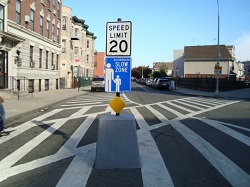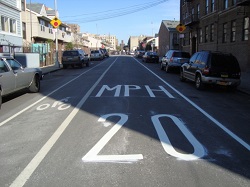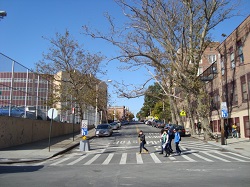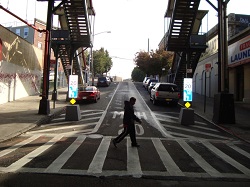Slow Zones
New York City, New York
Prepared by Ann McGrane, University of North Carolina Highway Safety Research Center. Information provided by Rob Viola and Scott Johnson, New York City Department of Transportation, New York, New York.
New York City, New York
Prepared by Ann McGrane, University of North Carolina Highway Safety Research Center. Information provided by Rob Viola and Scott Johnson, New York City Department of Transportation, New York, New York.
Many motorists drove on city roadways without paying much attention to how their driving affected the residents of the area. Many motorists traveled at speeds inappropriate for neighborhoods and cut through residential areas to get to major roadways or highways. The high speeds posed risks for pedestrians, particularly around schools, community centers, parks, and homes. New York City wanted to encourage drivers to adopt driving habits appropriate for residential neighborhoods.

Vyse Gateway Treatment.
Cities in Europe, such as London and Amsterdam, experimented with reduced speed limits in residential areas; after implementation, there was a dramatic reduction in pedestrian injuries within the zones. The New York City Department of Transportation wanted to try a similar "Slow Zone" program by creating 20 mi/h zones in certain neighborhoods throughout the city. The goal was to improve the safety and quality of life of residents in the zones.
The Claremont neighborhood of the Bronx was a very residential neighborhood that was clearly delineated by an elevated train, industrial zone, and highway. When the NYC Department of Transportation (NYCDOT) created a preliminary list of neighborhoods that could benefit from being a Slow Zone, Claremont ranked first in the number of killed or seriously injured pedestrians per 100,000 people, and it ranked #2 for the total number of schools within the neighborhood. Additionally, Claremont had a pedestrian fatality occur between the years 2005 and 2009. These factors were the reason Claremont was chosen as the pilot area for the New York City Neighborhood Slow Zone program.

In-street speed limit markings emphasize the slow zone speed limit.
In 2011, the NYC DOT created the Neighborhood Slow Zone program. Slow Zones were residential areas that encompassed about a quarter square mile, or five by five city blocks, and deployed traffic calming measures that self-enforced speed limits of 20 mi/h. Slow Zones generally had defined boundaries such as major roadways, railways, or commercial zones.
To create a Slow Zone, the NYCDOT installed gateways at neighborhood entryways. The gateways narrowed neighborhood entrances with road markings and signaled to drivers they were entering a 20 mi/h area with in-street signs with bases. One to two parking spaces were removed to install each gateway treatment. The resulting intersection daylighting increased the visibility of pedestrians using the crosswalks.
In addition to gateways, speed humps were placed throughout the Slow Zone with a geographic coverage of about one speed hump per three blocks. Finally, 20 mi/h in-street markings were placed throughout the Slow Zone. These traffic calming countermeasures were relatively inexpensive, created an environment that was unwelcoming to cut-through traffic, and naturally reduced motorist speeds.

Gateway in school zone.
A variety of factors determined whether a location was feasible as a Slow Zone. A points-based zone ranking system was created. Points were either awarded or subtracted based on how many crashes occurred in the area, neighborhood features, and the physical layout of the zone. The amount of crashes and injuries was a heavily weighted factor, and it was evaluated on an overall and a per mile basis. Neighborhoods were given points for schools, senior centers, and other pedestrian attractors (for example, subway stations) within their boundaries. Community support was a critical component for Slow Zone implementation; points were awarded for letters of support from community organizations and political leaders.
Points were subtracted if fire stations and hospitals were located within the boundary, as it was important that emergency response times weren't hindered by the traffic calming features proposed for the zone. Truck routes inside a zone boundary resulted in a zone being immediately removed from consideration. The NYCDOT used this point system to create a prioritized list of potential Slow Zones.

Freeman Street Gateway.
The Slow Zone in the Claremont neighborhood has received favorable reviews. Police officers reported less aggressive driving in the area. At 6 of the 7 locations where speed humps were installed, the 85th percentile speed was reduced. The only issue as of January 2012 was that about half of the in-street gateway signs had been damaged by vehicles. Creation of the Neighborhood Slow Zone was relatively simple for the NYCDOT because the traffic calming measures were standard treatments and the project only required crash and speed data.
In November 2011, the NYCDOT created an online application that community stakeholders could fill out to try to qualify to become a Neighborhood Slow Zone. The application period was from November 2011 to February 2012. During that period, the department received about 100 requests, about 25 of which were detailed enough to rank in order of priority. The good response rate showed that residents and community boards of New York City were interested in creating safe residential neighborhoods through the creation of Slow Zones. The DOT plans to implement 13 Slow Zones in 2012 and 2013.
Rob Viola
Project Manager
Division of Traffic and Planning
Office of Research, Implementation and Safety
New York City Department of Transportation
Phone: (212) 839-7752
Email: rviola@dot.nyc.gov